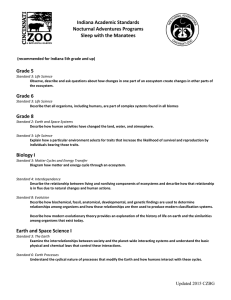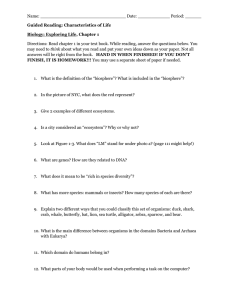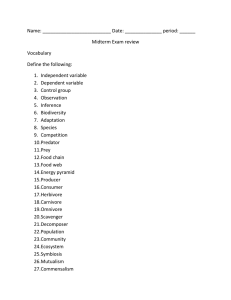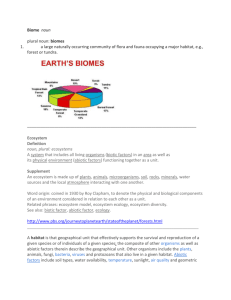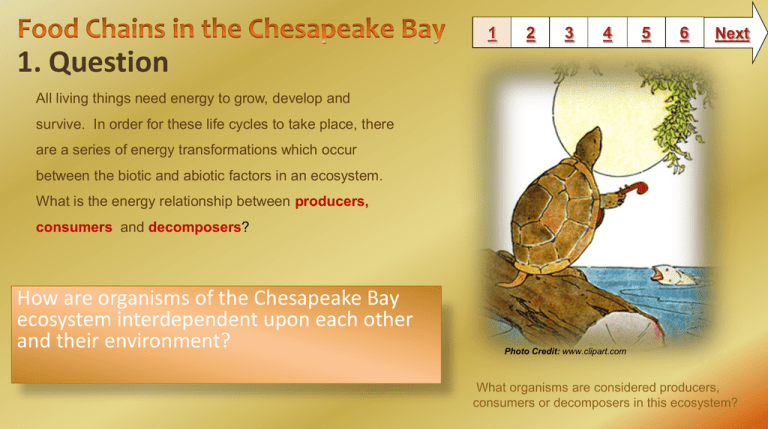
1
2
3
4
5
6
Next
1. Question
All living things need energy to grow, develop and
survive. In order for these life cycles to take place, there
are a series of energy transformations which occur
between the biotic and abiotic factors in an ecosystem.
What is the energy relationship between producers,
consumers and decomposers?
How are organisms of the Chesapeake Bay
ecosystem interdependent upon each other
and their environment?
Photo Credit: www.clipart.com
What organisms are considered producers,
consumers or decomposers in this ecosystem?
2. Information Sources
1
2
3
4
5
6
Next
You will review the following e-resources in order to explore the energy
relationships in the Chesapeake Bay ecosystem. Be sure to verify with your
teacher what star that you will be for the activity.
Click on the star and read
View
Click on the star and read the selection and
complete tasks 1-3
View
All Stars
View Food Chain interactive
View Sunny Meadows slides (1-10)
Run the Sunny Meadows Simulation
Photo Credit: NCTC Image Library, USFWS
How do the biotic and abiotic factors interact in this
fragile ecosystem?
3. Student Activity
You will complete the following tasks:
A.Complete Activity A to review
consumer, producer, and
decomposer
B. Select two habitats and
complete two Food Web
Activities.
1
2
3
4
5
6
Next
4. Assessment Activity
1
2
3
4
5
6
Next
You will apply your new learning
regarding the interdependence
of organisms in the Chesapeake
Bay ecosystem
Assessment Activity.
How are the osprey, the sun, herring, zooplankton, bass
and algae interdependent?
5. Enrichment Activities
1
2
3
4
5
6
Real World Applications:
•
•
•
Food Chain Effects
The Relationship between Wetlands and the Food
Chain
The Science Keeping Fish Alive in Aquariums
What would be the impact of the
population of rock fish if the SAV
population decreased? Why?
Next
6. Teacher Support Materials
BCPS Curriculum
SWBAT identify the transfer of energy among organisms IOT explain how
the amount of energy remains constant in an ecosystem.
Maryland State Curriculum:
Environmental Science
The student will demonstrate the ability to use the scientific skills and
processes (Core Learning Goal 1) and major environmental science
concepts to understand interrelationships of the natural world and to
analyze environmental issues and their solutions.
Indicator 6.2.1 The student will explain how organisms are linked by the transfer and
transformation of matter and energy at the ecosystem level. At least —
–
–
–
–
Photosynthesis/respiration
Producers, consumers, decomposers
Trophic levels
Pyramid of energy/pyramid of biomass
Common Core State Standards
Reading: 1. Read closely to determine what the text says explicitly and to
make logical inferences from it; cite specific textual evidence when writing
or speaking to support conclusions drawn from the text.
Writing: 7. Conduct short as well as more sustained research projects
based on focused questions, demonstrating understanding of the subject
under investigation.
1
2
3
4
5
6
Standards for the 21st Century Learner
1.1.6 Read, view, and listen for information presented in any
format (e.g. textual, visual, media, digital) in order to make
inferences and gather meaning.
2.1.3 Use strategies to draw conclusions from information
and apply knowledge to curricular areas, real-world
situations, and further investigations.
Maryland Technology Literacy Standards for Students
3.0 : Use a variety of technologies for learning and
collaboration.
Time Frame: 1-2 50 min class sessions
Differentiation:
•
Direct students to use comprehension tools included in
databases, such as: audio read-aloud, labeled reading
levels, and embedded dictionaries.
Learning Styles:
Notes to the teacher: For the assessment, ensure that the
students enable the macro by clicking on the icon in the
formula bar.
Last update: July 2011
Created Keishauna Banksto email address
BCPS Research Module or Slam Dunk Model, Copyright 2005, Baltimore County Public Schools, MD, all rights reserved. The models may be used for educational, non-profit school use
only. All other uses, transmissions, and duplications are prohibited unless permission is granted expressly. This lesson is based on Jamie McKenzie’s Slam Dunk Lesson module available
at http://questioning.org/module2/quick.html.


